
Kaare M. Risung
Partner
Oslo
Newsletter
by Kaare M. Risung
Published:
14 June 2021 the Norwegian Ministry of Local Government and Modernisation (the "Ministry") published a consultation paper and a draft regulation for end user financing of access to functional broadband connections and voice services in rural areas. The deadline for submitting responses is set at 26 July 2021.
The primary policy tool for providing connections in areas not serviced on a commercial basis has been project financing available at a regional level. There are however still SMEs and homes too distant from neighbors to be included in build-out projects and the new scheme aims to provide connection also to such single users. The legislative background for the initiative is the EU ecom Code article 84, which interestingly enough has yet to be implemented in Norway.
In this article we describe the solution proposed by the Ministry.
The scheme will apply for consumers' permanent residences (not second homes) and SMEs with fewer than 100 employees - both only on the Norwegian mainland (e.g. not on Svalbard and Jan Mayen). The support will be paid directly to the applicant, and not to the provider. The Ministry refers to a study that concludes there are about 11,300 buildings today without at least a 20 Mb/s connection. Despite citing technology neutrality, the Ministry then brings this down to 1,400 due to the possibility of providing coverage to 9,900 of these buildings by way of an outdoor antenna for reception of terrestrial mobile network signals. The ministry assumes an average cost of NOK 6,100 for establishment of such antennas. No explanation is offered why for example satellite coverage would not be an alternative for those 9,900 buildings.
The Ministry cites preamble 230 of the ecom Code in support of technology neutrality. As opposed to in the UK, the Ministry explicitly states that satellites in low latency low orbits may be a satisfactory technological solution, provided the remaining characteristics are fulfilled, namely:
Any service must be provided for at least 2 years, with an option of the user to extend up to 5 years. It is unclear if the option to extend to 5 years is in addition to or including the first 2 years.
The support is for network and network equipment. End user equipment including the modem and router is excluded. Grant may be conditioned on the applicant conditioning the premises, such as cutting down trees to provide line of sight. The Ministry proposes a maximum support of either NOK 300,000 or NOK 400,000 and requests input on which limit to select. Only establishments costing more than NOK 5,000 will be supported (NOK 3,000 for voice service). The support will be provided to the end user and not to the provider. The network and equipment established shall still be owned by the provider. The combination of payments to the end user, ownership by the provider, obligation of provider service to the customer only 5/7 year and equipment with potential life cycle of, say 20, years, could lead to some interesting issues.
The scheme will be under central management by the Norwegian Communications Authority (the "Nkom"), or regionally by county (Nw: fylke) administrations. Administration by Nkom will be more efficient and ensure consistency in application of the rules, but will also lack the local knowledge and coordination with the regional broadband projects. The Ministry requests input on who should administer the scheme.
The proposal is surprisingly silent on which providers will be selected for each project. The key details included are that the potential providers shall enter into an agreement with Nkom and that the section shall be conducted according to a public procurement process. There are no details on whether such selection would be for each project, a group of projects, per year, district or otherwise. Presumably this means a public procurement process for each end user. This would however be extremely inefficient for establishments costing only fractionally above the threshold of NOK 5,000/3,000.
In its analysis of potential costs, the Ministry assumes that most connections may be established by way of outdoor antennas, repeaters and other measures in the mobile networks or radio link. No explanation is offered why such solutions should be preferred over satellite.
We also note that the Ministry subtracts "customer value" from its calculations. No details are provided on in which manner this figure would impact selection of providers or the level of financing.
The goal to make broadband connection available to all is noble. Cost of up to NOK 400,000 for a single connection and a large bureaucracy for a maximum of few thousand, or even a few hundred connections, seem however excessive if technology neutrality is applied in practice. The Ministry recognizes low orbit satellite systems as providing functional broadband. Several such systems are rapidly being deployed. The proposal lack clarity in selection of providers, and we encourage interested parties to submit responses by the deadline 26 July.
